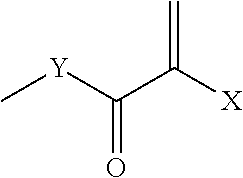Biocompatible, biomimetic ampholyte materials
a biomimetic and ampholyte technology, applied in the field of ampholyte compound and materials, can solve the problems of poor mechanical strength, high mechanical strength, low degradability, etc., and achieve the effects of high biocompatibility, biocompatibility, and hydrophilicity
- Summary
- Abstract
- Description
- Claims
- Application Information
AI Technical Summary
Benefits of technology
Problems solved by technology
Method used
Image
Examples
example 1
Synthesis of 2-((2-(methacryloyloxy)ethyl)dimethylammonio)ethyl 2-methoxyethyl phosphate using SCHOTT Duran pressure bottle
[0127]The first two steps to provide 2-chloro-1,3,2-dioxaphospholane oxide were previously described and carried out according to the methods of Lucas and Edmundson.
[0128]Freshly distilled 2-methoxyethanol was blended in an oven-dried round bottom flask, flushed with nitrogen, with anhydrous tetrahydrofuran and freshly distilled triethylamine. The mixture was stirred under N2 for 10 min and cooled down to −20° C. A solution of 2-chloro-1,3,2-dioxaphospholane oxide in anhydrous tetrahydrofuran was added slowly at −20° C. over a period of 20 min. Once the addition was finished, the mixture was stirred a further 2 hours at −10 / −20° C., followed by 2 hours at 0 / 5° C. and slowly allowed to warm up to room temperature over 1 hour. The precipitate of triethylamine hydrochloride was filtered through celite and glass wool, and THF was removed by distillation. The interme...
example 2
Synthesis of 2-((2-(methacryloyloxy)ethyl)dimethylammonio)ethyl 2-methoxyethyl phosphate using SCHOTT Duran pressure bottle and increased concentration of reagents in solvent
[0131]The first two steps to provide 2-chloro-1,3,2-dioxaphospholane oxide were previously described and carried out according to the methods of Lucas7 and Edmundson8.
[0132]Methoxyethyl-1,3,2-dioxaphospholane oxide was prepared as described in Example 1. The methoxyethyl-1,3,2-dioxaphospholane oxide (1 equivalent) was blended in an oven-dried glass bottle (SCHOTT Duran 100 mL) with freshly distilled 2-(dimethylamino)ethyl methacrylate (Aldrich) (1 equivalent) and 2000 ppm of 2-methoxyphenol (Aldrich) with freshly distilled acetonitrile (2 molar). The mixture was stirred at 120° C. for 24 hours. At the completion of the reaction, most of the acetonitrile was removed in a stream of nitrogen. The remaining yellow / brown oil was dissolved in a minimum amount of anhydrous methanol and reprecipitated from anhydrous die...
example 3
Synthesis of 2-((2-(methacryloyloxy)ethyl)dimethylammonio)ethyl 2-methoxyethyl phosphate using microwave energy
[0134]The first two steps to provide 2-chloro-1,3,2-dioxaphospholane oxide were previously described and carried out according to the methods of Lucas7 and Edmundson8.
[0135]Methoxyethyl-1,3,2-dioxaphospholane oxide was prepared as described in Example 1. The Methoxyethyl-1,3,2-dioxaphospholane oxide obtained (1 equivalent) was blended in an oven-dried microwave thick wall vessel with freshly distilled 2-(dimethylamino)ethyl methacrylate (Aldrich) (1 equivalent) and 2000 ppm of 2-methoxyphenol (Aldrich) with freshly distilled acetonitrile (2M). The reaction mixture was placed in a CEM Discover microwave, stirring at 125° C. for 4 hours with a power of 150 watts. At the completion of the reaction, most of the acetonitrile was removed in a stream of nitrogen. The remaining brown oil was dissolved in a minimum amount of anhydrous methanol and reprecipitated from anhydrous dieth...
PUM
| Property | Measurement | Unit |
|---|---|---|
| equilibrium water content | aaaaa | aaaaa |
| weight | aaaaa | aaaaa |
| power | aaaaa | aaaaa |
Abstract
Description
Claims
Application Information
 Login to View More
Login to View More - R&D
- Intellectual Property
- Life Sciences
- Materials
- Tech Scout
- Unparalleled Data Quality
- Higher Quality Content
- 60% Fewer Hallucinations
Browse by: Latest US Patents, China's latest patents, Technical Efficacy Thesaurus, Application Domain, Technology Topic, Popular Technical Reports.
© 2025 PatSnap. All rights reserved.Legal|Privacy policy|Modern Slavery Act Transparency Statement|Sitemap|About US| Contact US: help@patsnap.com



